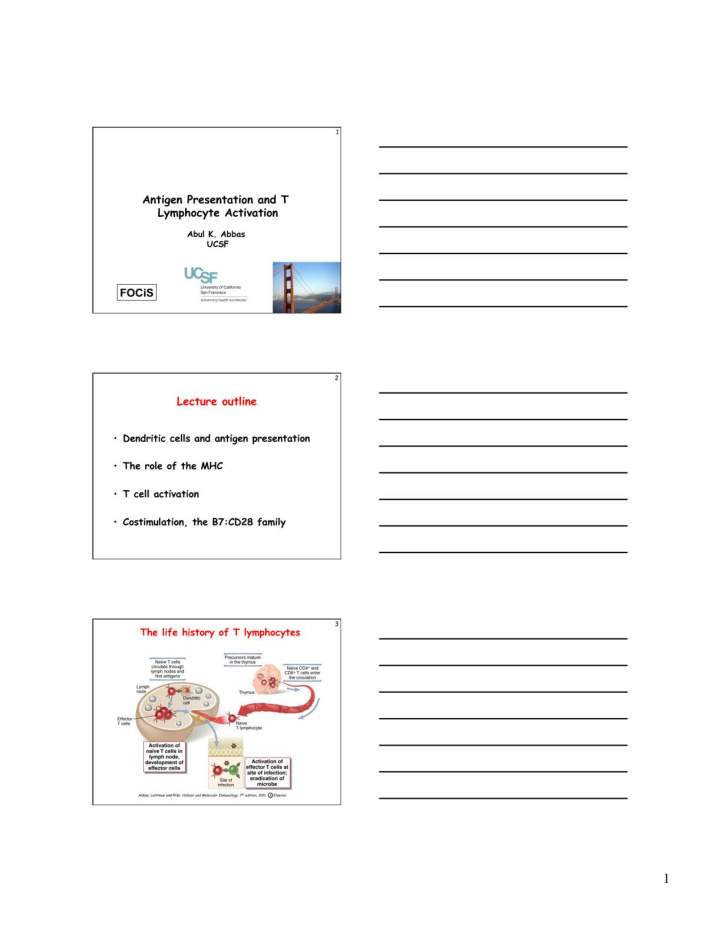



4 The challenge for lymphocytes • Very few lymphocytes in the body are specific for any one microbe (or antigen) – Specificity and diversity of antigen receptors: the immune system recognizes and distinguishes between 10 6 - 10 9 antigens; therefore, few lymphocytes with the same receptors 5 The challenge for lymphocytes • Very few lymphocytes in the body are specific for any one microbe (or antigen) – Specificity and diversity of antigen receptors: the immune system recognizes and distinguishes between 10 6 - 10 9 antigens • Lymphocytes must be able to locate microbes that enter and reside anywhere in the body – Usual routes of entry are through epithelia, but infections may take hold anywhere 6 The challenge for lymphocytes • Very few lymphocytes in the body are specific for any one microbe (or antigen) • Lymphocytes must be able to locate microbes that enter anywhere in the body • Lymphocytes must respond to each microbe in ways that are able to eradicate that microbe; best exemplified by T cells – Extracellular microbes: antibodies; destruction in phagocytes (need helper T cells) – Intracellular microbes: killing of infected cells (need CTLs) – How do T cells distinguish antigens in different cellular locations? 2 �
10 Why are dendritic cells the most efficient APCs for initiating immune responses? • Location: at sites of microbe entry (epithelia), tissues • Receptors for capturing and reacting to microbes: Toll-like receptors, other receptors • Migration to T cell zones of lymphoid organs – Role of CCR7 – Co-localize with naïve T cells • Maturation during migration: Conversion from cells designed for antigen capture into cells for antigen presentation and T cell activation • Practical application: dendritic cell-based vaccines for tumors Take home messages 11 What do T cells see? • All functions of T cells are mediated by interactions with other cells – Helper T cells “help” B cells to make antibodies and “help” macrophages to destroy what they have eaten – Cytotoxic (killer) T lymphocytes kill infected cells • How does the immune system ensure that T cells see only antigens on other cells? 12 What do T cells see? • All functions of T cells are mediated by interactions with other cells – Helper T cells “help” B cells to make antibodies and “help” macrophages to destroy what they have eaten – Cytotoxic (killer) T lymphocytes kill infected cells • To ensure cellular communications, T cells see antigens NOT in the circulation but only when displayed by molecules on the surface of other cells – These molecules are HLA (generic name: MHC) and the cells displaying the antigen are APCs Take home messages 4 �
16 Functional importance of class II MHC- � associated antigen presentation Macrophage Microbial antigen Antigen is CD4+ T cells secrete ingests is presented by recognized cytokines that activate microbe class II MHC by CD4+ T macrophage to destroy cell ingested microbe B cell Antigen is Antigen is CD4+ T cells secrete cytokines that activate B cells to recognizes presented by recognized differentiate into antibody antigen and class II MHC by CD4+ T secreting plasma cells ingests it cell 17 � Functional importance of class I MHC- associated antigen presentation Viral antigen is Viral antigen Antigen is Infected cell is produced inside is presented recognized by killed, eliminating virus-infected by class I CD8+ the infection cell MHC cytotoxic (killer) T cell 18 Functions of antigen-presenting cells • Capture antigens and take them to the “correct” place – Antigens are concentrated in peripheral lymphoid organs, through which naïve lymphocytes circulate • Display antigens in a form that can be recognized by specific lymphocytes – For T cells: MHC-associated peptides (cytosolic peptides to class I, vesicular peptides to class II) – For B cells: native antigens • Provide “second signals” for T cell activation – Critical for initiation of responses Take home messages 6 �
Major functions of selected B7-CD28 28 � family members • B7-CD28: initiation of immune Activation responses • ICOS-ICOS-L: T cell help in germinal center reactions (antibody responses) Inhibition • B7-CTLA-4: inhibits early T cell responses in lymphoid organs • PD-1:PD-L1,2: inhibits effector T cell responses in peripheral tissues 29 � Complexities and unknowns of B7:CD28 costimulation • Different T cell populations vary in their dependence on B7:CD28: – Naïve > activated > memory – CD4 > CD8 – Regulatory T cells (controllers of immune responses) are also B7-dependent • Redundancy of B7-1 and B7-2? • Does B7 signal backwards into APCs? Therapeutics based on the B7:CD28 family 30 � 1. Costimulatory blockade CTLA-4.Ig inhibits T cell activation in diseases caused by T cell responses-- rheumatoid arthritis, graft rejection, psoriasis 10 �
31 � Costimulatory blockade therapy • B7-antagonist (CTLA-4.Ig, Abatacept) approved for RA, kidney allograft rejection (high-affinity version, Belatacept) – Risks: • Reducing responses against infections 32 32 � � Costimulators other than B7:CD28 • Many proteins of the TNF-receptor family are expressed on T cells and implicated in T-cell activation and control – Functions often demonstrated in complex experimental systems or in vitro – Roles in disease (human or animal models) not definitely established • Possible therapeutic targets? 33 � T cell expansion and contraction (decline) Many aspects of T cell responses and functions are mediated by cytokines: initial activation -- IL-2; maintenance of memory cells -- IL-7; effector functions -- various � 11 �
34 Clonal expansion of T cells • Stimulated mainly by autocrine IL-2 – Antigen recognition � secretion of IL-2 and expression of high-affinity IL-2 receptors � preferential expansion of antigen-specific cells • CD8+ T cells may expand >50,000-fold within a week after an acute viral infection – Up to 10% of all CD8+ T cells in the blood may be specific for a pathogen – Minimal expansion of “bystander” cells (not specific for the virus) – CD8+ cells expand much more than do CD4+ cells 12 �
Recommend
More recommend